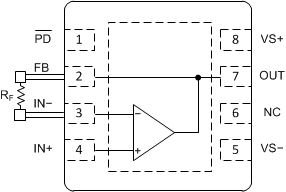ZHCSOI9A July 2022 – December 2022 OPA817
PRODUCTION DATA
8.3.2 Feedback Pin
For high speed analog design, minimizing parasitic capacitances and inductances is critical to get the best performance from a high-speed amplifier such as the OPA817. Parasitic capacitance and inductance are especially detrimental in the feedback path and at the inverting input. They result in undesired poles and zeroes in the feedback that could result in reduced phase margin or instability. Techniques used to correct this phase margin reduction often result in reduced application bandwidth. To keep system engineers from making these tradeoff choices and to simplify the PCB layout, OPA817 features an FB pin on the same side as the inverting input pin (IN–). Figure 8-4 shows how this feature allows for a very short feedback resistor (RF) connection between the FB and the IN– pin, which minimizes parasitic capacitance and inductance with minimal PCB design effort. Internally the FB pin is connected to OUT pin through metal routing on the silicon. Due to the fixed metal sizing of this connection, the FB pin has limited current carrying capability. Therefore, the specifications in the Absolute Maximum Ratings section must be adhered to for continuous operation. For applications requiring high accuracy, the metal routing resistance from OUT to FB can be considered and added to RF to set the desired gain. For more information, see Section 7.5.
 Figure 8-4 RF Connection Between FB and IN– Pins
Figure 8-4 RF Connection Between FB and IN– Pins